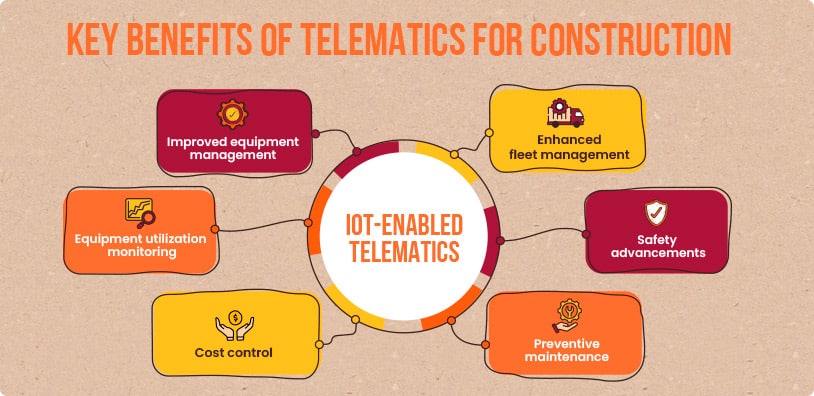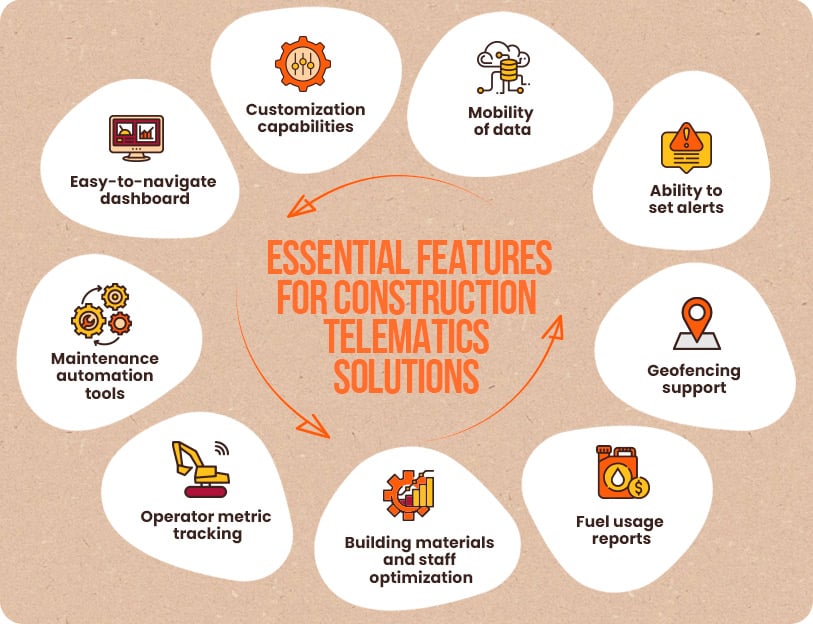
Picture this: a construction site where every vehicle, machine, and tool is seamlessly interconnected, rendering vital information that enhances efficiency, safety, and cost-effectiveness. Sounds great, right? With telematics for construction technology, this is the reality of modern building businesses.
Benefits from the technology naturally lead to the growth of the global construction & heavy equipment telematics market size. According to the Markets and Markets report, it is projected to hit USD 1,498 million by 2026.
In this article, we will enlighten what is telematics, how it works, and what advantages it provides to the construction industry. Also, we will define must-have features for telematics constriction solutions, and provide A-Team Global expertise in the technology.
What is Telematics?
The word telematics derives from telecommunications and informatics. To put it simply, it’s all about the transmission of computerized information from tracking assets to the user interface. Telematics is a technology used to monitor various data and information related to vehicles, machines, equipment, other objects, and physical assets. In recent years, telematics has changed numerous industries, especially, fleet management and construction.
Despite fleet management and construction being two different business verticals, they often complement each other. In the context of a constriction site, fleet management allows project managers to orchestrate data and information from trucks, excavators, and other kinds of vehicles.
Add to that the ability of telematics to gather data from cranes, power tools, and equipment—altogether, it creates a digital network essentially facilitating construction projects.
But how it works? Let’s find it out now.
Components of a telematics system
Telematics for construction equipment involves Global Positioning System (GPS) tracking, data analytics, sensors, and connectivity.
GPS Tracking
An essential element within the telematics toolkit is the GPS receiver. To accurately determine the equipment's and tracking assets' location, it picks up signals from GPS satellites. Serving as a cornerstone of telematics systems, the GPS receiver delivers accurate and up-to-the-minute location information.
Data analytics
Telematics systems collect vast amounts of data, ranging from vehicle speed and fuel consumption to engine health and equipment usage. Advanced data analytics tools process this information, providing valuable insights into operational patterns, potential issues, and opportunities for optimization. This data-driven approach enhances decision-making, leading to cost savings and improved project efficiency.
Sensors and connectivity
Telematics systems utilize a variety of sensors installed on equipment and vehicles. These sensors can monitor engine performance, equipment usage, fuel levels, and environmental conditions such as temperature and humidity. Connected through wireless networks, these sensors continuously transmit data to a centralized platform, ensuring that managers have up-to-date information at their fingertips.
Benefits of telematics solutions for construction

Technical capabilities of telematic technology provide construction businesses with a wide range of advantages. Let’s review the boldest ones in detail.
Improved equipment utilization
As to the construction equipment, telematics provides managers with a set of actionable information. Through analysis of data on equipment runtime, idle periods, and movement across job sites, construction firms can refine their equipment allocation strategies. This results in fewer occurrences of overuse or underuse, ultimately maximizing the efficiency of every asset.
Enhanced construction fleet telematics
Telematics enhances vehicle dependability, streamlines fleet administration, and enhances driving safety. With GPS tracking capabilities, construction managers can oversee vehicle locations and movements instantly. This enables optimized routing, decreases unauthorized vehicle operations, and boosts overall fleet effectiveness. By reducing fuel consumption and unnecessary travel, telematics substantially lowers operational expenses.
Proactive maintenance
Telematics systems facilitate predictive maintenance through ongoing monitoring of construction equipment health and performance. Analysis of engine diagnostics and equipment operation data allows managers to create optimized maintenance schedules. This proactive strategy mitigates the likelihood of unforeseen breakdowns, reduces downtime, and prolongs equipment lifespan.
Increased safety
Safety stands as a top priority within the construction sector, with telematics playing a pivotal role in its enhancement. Through geofencing technology, virtual perimeters can be established around hazardous zones at job sites, triggering alerts upon equipment entry into these areas. Furthermore, sensors can monitor variables such as equipment speed, abrupt braking, and unsafe driving practices. By pinpointing risky behaviors, telematics aids in accident prevention and fosters a safer working environment for construction teams.
Data-driven decision making
The wealth of data collected by telematics systems provides construction companies with valuable insights for decision-making. Data analytics tools process information on equipment performance, job site productivity, and more. This empowers managers to make informed decisions, optimize workflows, allocate resources effectively, and identify areas for improvement.
Enhanced customer service
With telematics, construction companies can provide better customer service through improved project visibility and transparency. Clients can receive real-time updates on project progress, equipment availability, and estimated completion times. This level of transparency builds trust and satisfaction among clients, leading to stronger relationships and potential repeat business.
Environmental sustainability
Telematics for the construction industry is a game-changer to environmental sustainability. By monitoring fuel consumption, optimizing routes, and reducing idle times, companies can minimize their carbon footprint. This not only aligns with corporate social responsibility goals but also helps to meet regulatory requirements for emissions reductions.
Core features of a construction telematics solution

The development of telematics software products is a challenge. A tech vendor must possess solid tech expertise in the field and sufficient tech stack to cover all business needs. When considering a telematics solution for construction sites, here are key features to look for:
- Unified dashboard: Ensure the system offers a single-window transparency. With the likelihood of managing multiple sites concurrently, having all assets tracked and monitored through an easily navigable dashboard is essential.
- Customization options: Seek platforms that allow for tailored filters and personalized report creation, aligning with specific business requirements and workflows.
- Data mobility: Opt for cloud-based software to facilitate seamless access to telematics data across a spectrum of devices, including mobile phones, tablets, laptops, and desktops.
- Alert setting capabilities: Enhance security measures with features such as geofencing and time-fencing, helping prevent theft and notifying of any unauthorized usage. Additionally, schedule usage alerts to assist managers in avoiding equipment overuse.
- Maintenance automation: Leverage telematics tracking to efficiently manage both preventative and predictive maintenance tasks, thereby minimizing unexpected equipment breakdowns and disruptions.
- Driver performance tracking: Boost productivity and enhance safety and regulatory compliance by utilizing tools that offer insights into performance trends and enable the establishment of performance benchmarks.
- Fuel consumption reports: Monitor fuel usage closely with detailed reports, aiding in cost optimization strategies.
- Building materials and staff optimization: Look for features that facilitate the optimization of resources, including materials and staff allocation, to streamline operations and enhance cost efficiency.
- Geofence support: Geofencing technology in construction sites provides real-time alerts and notifications when equipment enters or exits designated areas, enhancing site security and safety measures. It also enables better monitoring of equipment usage within specific zones, optimizing operational efficiency and minimizing the risk of unauthorized access.
When choosing a tech vendor for your construction business project, make sure they are capable of providing you with the listed features.
Implementing telematics in your construction business
Choosing a reliable telematic provider can be challenging. Considering it’s a vital decision for any project, you have to review a potential partner carefully. Here are some practical recommendations that will help you to make your choice.
Evaluate a provider’s reputation and experience. Explore online reviews and testimonials about a company. Check out the company’s profiles on such platforms as Clutch and Upwork or research industry-specific forums. Review case studies, inquire for references, and success stories with clients to understand the background of the provider.
Consider customer support and training. Make sure the telematic provider offers product onboarding for your managers and post-production customer support.
Verify the integration with existing systems. Ask the provider if their solutions can be seamlessly integrated into your software environment.
These simple, yet powerful tips will significantly increase your chances of signing up a best-fit telematics provider.
A-Team Global expertise in telematic solutions
Our company has been providing telematic-focused software development services for companies in different industries for more than 10 years. We create customized and comprehensive solutions using the Total API platform that processes data from different types of sensors.
Having a pool of talents on board with deep expertise in telematic technology, we successfully delivered dozens of complicated business software projects. The company’s tech stack includes Asp.Net, Node.js, Laravel, PHP, Vue, React, Angular, and more. At this point, we are capable of developing software products for versatile business domains. We help companies address their routine and strategic tasks through:
- fleet management solutions
- production activities monitoring systems
- operations analysis
- equipment remote monitoring
- remote product inventory count
- quality control systems.
A-Team Global is flexible and can create construction telematics solutions from scratch, or you can reinforce your in-house team with our tech-savvy engineers. You can choose a dedicated team or staff augmentation approach.
The bottom line
Whether you're a fleet management or a construction business, telematics offers unparalleled opportunities to streamline operations and enhance workflow. Keep in mind, that a comprehensive construction telematics solution should include a unified, customizable platform with seamless data accessibility, advanced security measures, maintenance automation tools, driver performance insights, fuel consumption tracking, and optimization features for resources.
These elements collectively contribute to improved operational efficiency, enhanced safety, and cost-effective management of construction assets and activities. Since telematics is a sophisticated technology, the recipe for success is to choose a reliable tech vendor. If you are looking for the one, A-Team Global got you covered.
you may also want to read

Hire Laravel Framework Developer: Tips and Offers
Do you dream of a dynamic website, a secure eCommerce store, or a new game but lack the resources for...

AI in HR: Transforming Human Resources
AI in HR is promised to change the recruitment operational activities dramatically. Despite the changes expected to be grasped by...

Python Telematic Solutions: Unfolding Capabilities for Fleet Management
The success of transportation and logistics companies is defined by how efficiently their fleet operates. This includes vehicle tracking, route...
